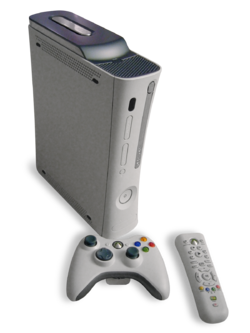Welcome to Xbox 360 Console Info!
December 27th 2009


| Manufacturer | Microsoft | |
| Type | Video game console | |
| Generation | Seventh | |
| First avaible | November 22, 2005 | |
| CPU | 3.2 GHz PPC Tri-Core Xenon | |
| GPU | 500 MHz ATI Xenos | |
| Media | DVD, DVD-DL, CD, Add-On: HD DVD | |
| System Storage | 20, 60, or 120 GB hard drive, 64, 256 or 512 MB memory cards | |
| Controller input | 4 maximum ( wireless or wired, a combonation of either ) | |
| Connectivity | 3 × USB 2.0, IR port, 100Mbit Ethernet | |
| Online Service | Xbox live | |
| Predecessor | Xbox |
General Information
The Xbox 360 is the second video game console produced by Microsoft, and was developed in cooperation with IBM, ATI, and SiS. Its Xbox Live service allows players to compete online and download arcade games and content such as game demos, trailers, TV shows, music videos, or rented movies. The Xbox 360 is the successor to the Xbox, and competes with Sony's PlayStation 3 and Nintendo's Wii as part of the seventh generation of gaming systems. The Xbox 360 was officially unveiled on MTV on May 12, 2005, with detailed launch and game information divulged later that month at the Electronic Entertainment Expo (E3). It is the first console to provide a near-simultaneous launch across the three major regions, and to provide wireless controller support at launch. The console sold out completely at release (with the exception of Japan) and, as of September 30, 2007, 13.4 million units have been sold worldwide. It is available in three versions, and has shipped more units worldwide than either of its competitors as of September 30, 2007.
Development
Known during development as Xenon, Xbox 2, Xbox FS, Xbox Next or NextBox, the Xbox 360 was conceived in early 2003. In February 2003, planning for the Xenon software platform began, and was headed by Microsoft VP J Allard. That month, Microsoft held an event for 400 developers in Bellevue, Washington, to recruit support for the system. Also that month, Peter Moore, former president of Sega of America, joined Microsoft. On August 12, 2003, ATI signed on to produce the graphic processing unit for the new console, a deal which was publicly announced two days later. The following month, IBM signed on to develop the triple-core CPU for the console. Before the launch of the Xbox 360, several alpha development kits were spotted using Apple's Power Mac G5 hardware. This was due to the system's PowerPC 970 processor running the same PowerPC architecture that the Xbox 360 would eventually run under IBM's Xenon processor.
Launch
The Xbox 360 was released on November 22, 2005, in the United States and Canada; December 2, 2005, in Europe and December 10, 2005, in Japan. It was later launched in Mexico, Colombia, South Korea, Hong Kong, Singapore, Taiwan, Australia, New Zealand, South Africa, Chile, India, Brazil, Poland, Czech Republic and Russia. Microsoft has additionally announced official launches in: Hungary, Slovakia, and the Philippines. In its first year on the market, the system launched in 36 countries, more countries than any console has launched in a single year. Due to its early launch, the Xbox 360 has a one-year lead on both of its competitors, Sony's PlayStation 3 and Nintendo's Wii.
Backward compatibility
Backward compatibility on the Xbox 360 is achieved through software emulation of the original Xbox. Emulated games are rendered in 720p, 1080i, or 1080p HD resolution with anti-aliasing enabled rather than the Xbox standard of 480p (anti-aliasing is also applied when the output resolution is 480p.) However there are also games that do not perform well in emulation; these often exhibit a lower framerate on the Xbox 360, as well as various sound bugs and occasional gameplay glitches. A hard drive and the downloading of an emulation profile is needed in order to play original Xbox games. Updated emulation profiles are automatically obtained through Xbox LIVE, or alternatively they can be burned to a CD with files downloaded from Xbox.com, or by ordering a free update disc from Microsoft. A full list of backward-compatible games is maintained at Xbox.com. The current U.S. list includes 464 games as of the November 2007 update; fewer titles are backward compatible in European and Japanese markets, with 295 and 101 titles respectively. Microsoft originally stated that they intend to release more emulation profiles as they become available, with a goal of making the entire Xbox library playable on the Xbox 360. They have since made multiple statements indicating that this may never be complete, and the rate of updates to the backwards compatibility list is in line with this stated attitude.
Sales
The Xbox 360 began production only 69 days before launch. As a result, Microsoft was not able to supply enough systems to meet initial consumer demand in Europe or North America. Many potential customers were not able to purchase a console at launch. This lack of availability caused Xbox 360 bundles to sell on eBay at inflated prices; some auctions exceeded US$6,000. Forty thousand units appeared on eBay during the initial week of release; this was 10% of the total supply. By year's end, Microsoft had shipped 1.5 million units, including 900,000 in North America, 500,000 in Europe, and 100,000 in Japan.Microsoft's gaming division is losing money. Through 2005, the Xbox gaming division had lost over $4 billion dollars. However, Microsoft expects the console will start making money in 2008. The losses are due to the market strategy of selling consoles below cost in order to obtain market saturation and gain profits on software and peripherals that have a much higher profit margin. Also notable is that Microsoft expects it needs to spend one billion dollars for repairs or replacements of bricked Xbox 360s.
